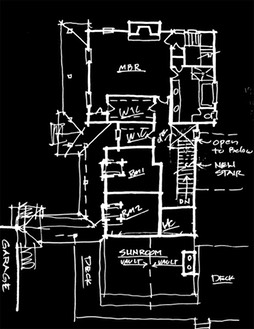Last week, we wrote about the pitfalls of starting a building project without an architect. So, what, exactly, does an architect do for you?
First, we protect all the parties by establishing standards that apply to your project.
For a typical project, here’s how we set standards so that you, our client, get the results you want:
Hamrock Farm House Plan Sketch-invert20160105
 To help you avoid surprises, we analyze and evaluate your needs and wants, so your project turns out the best way possible — and we verify the codes your project needs to meet. This is called the “Pre-Design Phase”.
To help you avoid surprises, we analyze and evaluate your needs and wants, so your project turns out the best way possible — and we verify the codes your project needs to meet. This is called the “Pre-Design Phase”.- So you can have a general idea of the layout and look, we sketch it roughly, while it’s still easy (and far less expensive!) to change. We make these adjustments on tracing paper or in a computer sketch. This is called the “Schematic Design Phase”. You’ll be able to make lots of changes here.
- To make sure everything works and is buildable, we adjust and refine the design with your input along the way. This is called the “Design Development Phase”. It’s still very inexpensive to make changes at this stage, and it’s where we work with you to tighten dimensions of rooms, based on your needs. We help you establish what you’re trying to accomplish and enable you to visualize your project through sketches, drawings and our 3D images before you ever commit to go forward with construction. You can make further changes here.
- Once you approve the design we’ve done for you, we show it with greater detail in technical drawings and written specifications. This is called the “Construction Document Phase”. These become a major part of the contract between the owner and the builder to construct the building. They’re also used for submitting to local permitting authorities to seek a building permit, so we often make adjustments to address their comments, helping make sure your building conforms to code requirements. You can still make changes here, since cost ramifications may be slight, compared to changes during construction.
- Construction documents then go to the builder for pricing, and we answer questions to assist this process. Once your building is under construction, we visit the site on occasion to observe and help ensure that construction complies with ideas shown in our construction documents. There are always variations, and substitutions that may be proposed. We’re ready to help work through these details with builder and owner. This is the “Contract Administration Phase”.
This is a tried and proven process that has been developed and refined over the years between the AIA (American Institute of Architects) and the rest of the building industry. It protects good clients and good contractors, so that everyone achieves the sturdy and useful satisfaction of an excellent building with a long, useful life.
Most of the services provided by an architect precede producing the construction drawings, or “blueprints”. Those are just the way we communicate our services. Here’s what they should do for you — a good set of construction docs:
- is based on adequate Pre-Design due-diligence by the architect — this identifies potential issues such as zoning, setbacks, regulations and land configuration to be addressed in the design and document phases;
- is an essential part of the agreement between owner and builder, so everybody knows what the built result will be;
- sets a baseline standard for the project that honorable builders and owners respect but that can be used as a last resort to protect all parties legally;
- protects the public, above all, from harm, and thus shields the owner from liability due to code violations;
- helps the owner, even if a change is needed, by showing where and how extensive the change may be;
- helps identify issues early, during the design phase, when it’s MUCH CHEAPER to make changes than during construction;
- reduces bad surprises, such as unexpected code violations that can shut down a project and delay completion;
- reassures local officials who otherwise might take a “hard line” against property owners who present inadequate documents to get a permit;
- allows the project to run with fewer delays to answer unnecessary questions;
- reassures quality builders that they’re bidding “apples-to-apples”, encouraging the best to work on your project;
- assures good GCs that their work is clearly defined — if they know what standards to meet to get them paid on time, they’ll work faster and more efficiently, saving time and money for the client.
A logical, straightforward process always works best; it avoids call-backs, warranty claims, and outright liability for damages caused by hidden defects.
If you find this content useful, please sign up for an occasional email update — PLUS you’ll be able to download our free guide, Blueprint for Getting a Building Permit!